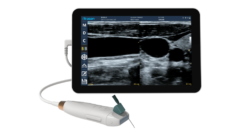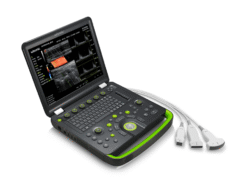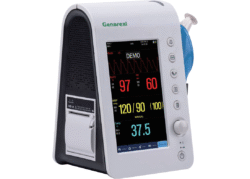Description
Introduction to Handheld Ultrasound Technology
Over the past decade, significant advancements have been made in the realm of medical imaging, particularly with the development of handheld ultrasound devices. These compact diagnostic tools have revolutionized the way healthcare professionals approach medical imaging, offering a stark contrast to traditional, bulkier ultrasound machines. Historically, ultrasound technology has been confined to hospitals and larger medical institutions due to the size, complexity, and cost of conventional ultrasound equipment. However, the emergence of handheld ultrasound devices has redefined this paradigm, making ultrasound imaging more accessible and versatile.
One of the primary distinctions between handheld ultrasound devices and conventional ultrasound machines lies in their portability. Unlike traditional systems that require a dedicated space and complex setup, handheld ultrasounds are compact and lightweight. This portability enables physicians and healthcare providers to conduct ultrasound imaging at the point of care, whether in a clinic, remote location, or even at a patient’s bedside. The ease of use associated with these devices further amplifies their appeal. Typically, handheld ultrasounds are user-friendly, equipped with intuitive interfaces that allow even those with minimal training to operate them effectively.
Moreover, the cost-effectiveness of handheld ultrasound devices presents a compelling advantage. Traditional ultrasound machines often come with substantial price tags, which can be prohibitive for smaller medical practices or facilities in developing regions. In contrast, handheld ultrasounds offer a more affordable alternative, without compromising on the quality of imaging. This democratization of ultrasound technology has the potential to enhance diagnostic capabilities and improve patient outcomes on a global scale.
In summary, the development of handheld ultrasound devices represents a significant leap forward in medical imaging technology. Their portability, ease of use, and cost-effectiveness make them an indispensable tool in modern healthcare. As we delve deeper into this blog, we will explore the transformative impact of these innovations and their implications for the future of medical diagnostics.
Image Quality and Diagnostic Applications

The image quality produced by handheld ultrasound devices has significantly improved over recent years, narrowing the gap between these portable solutions and traditional cart-based ultrasound systems. Technological advancements have played a pivotal role in enhancing image clarity and resolution, making these devices reliable tools for medical diagnostics. Notably, innovations such as advanced transducer technologies, improved software algorithms, and enhanced signal processing capabilities have been core contributors to the image quality now achievable by handheld ultrasound devices.
The superior image resolution delivered by these compact devices facilitates accurate and timely diagnoses, which is crucial in various medical scenarios. In emergency rooms, for instance, the portability and ease of use of handheld ultrasound devices allow for rapid assessment of patients, providing clear imaging results that help in the swift determination of conditions such as internal bleeding or fractures. These devices are particularly beneficial in rural healthcare settings, where access to large, traditional ultrasound machines may be limited. Handheld ultrasound devices bridge this gap, enabling healthcare providers to deliver quality care irrespective of geographic constraints.
Telemedicine has also significantly benefited from handheld ultrasound devices. The ability to connect these devices securely to tablets, PCs, or mobile phones facilitates real-time consultations with specialists from any location. This connectivity ensures that patients receive timely expert evaluations, crucial for conditions requiring immediate medical attention. Case studies have shown the effectiveness of this approach; for example, remote areas with limited access to specialized care have observed significant improvements in patient outcomes when local healthcare providers utilized handheld ultrasound devices during teleconsultations.
Specialist clinics have further capitalized on the advanced image quality of handheld ultrasound devices. Cardiologists, obstetricians, and gastroenterologists, among others, use these devices for initial assessments, routine monitoring, and follow-up appointments. Their lightweight and user-friendly design make them ideal for busy clinical environments, ensuring that specialists can perform thorough examinations without delay. Ultimately, the advancements in image quality and the diverse diagnostic applications of handheld ultrasound devices exemplify their transformative impact on modern medical imaging and patient care.
Image Archiving and Data Management Solutions
As handheld ultrasound devices become more prevalent in medical diagnostics, robust image archiving and data management solutions are essential to maintain comprehensive patient records and facilitate seamless ongoing medical care. These devices often feature built-in storage capabilities, allowing healthcare professionals to save and review ultrasound images directly on tablets, PCs, or mobile phones. This immediate accessibility optimizes workflow and enhances patient consultations by providing instant visual data.
However, built-in storage alone may not suffice for long-term data retention or when dealing with a large volume of patients. Cloud-based solutions offer scalable and versatile alternatives, enabling practitioners to securely store and access ultrasound images from any location. By integrating cloud solutions, healthcare facilities can benefit from massive storage capacities, real-time collaboration among medical teams, and the ability to back up data to prevent loss due to hardware failures.
The integration of handheld ultrasound devices with electronic health records (EHR) systems represents another critical advancement in data management. By synchronizing ultrasound images with EHRs, healthcare providers achieve a comprehensive view of patient history, enhancing diagnostic accuracy and personalized treatment plans. This synergy ensures that all relevant medical data is centralized, simplifying the retrieval process and improving clinical outcomes.
Security and compliance are paramount when storing and managing medical images and data. Handheld ultrasound devices and associated software must adhere to stringent regulatory standards such as the Health Insurance Portability and Accountability Act (HIPAA) in the United States or the General Data Protection Regulation (GDPR) in Europe. These regulations mandate the implementation of robust security measures, including data encryption, secure user authentication, and regular audits to protect patient confidentiality and data integrity.
In conclusion, effective image archiving and data management solutions are integral to the functionality and reliability of handheld ultrasound devices. By leveraging built-in storage, cloud-based systems, and EHR integration while maintaining rigorous security and compliance standards, healthcare providers can ensure that they offer high-quality, patient-centric care.
Connectivity and Compatibility: Tablets, PCs, and Mobile Phones
Handheld ultrasound devices have revolutionized the field of medical imaging by offering unprecedented connectivity and compatibility with various computing platforms, including tablets, PCs, and mobile phones. This seamless integration is facilitated by state-of-the-art technologies designed to enhance the functionality and accessibility of ultrasound imaging.
The connection between handheld ultrasound devices and these computing platforms is typically established via USB, Wi-Fi, or Bluetooth, ensuring a high degree of flexibility and convenience. For instance, many modern handheld ultrasound devices are equipped with plug-and-play USB functionality, allowing instant connection to laptops and desktop PCs. This ensures that healthcare professionals can use their existing computing equipment without the need for additional hardware.
When it comes to mobile phones and tablets, wireless connectivity is a game-changer. Wi-Fi and Bluetooth capabilities provide a cord-free experience, making it easier for practitioners to perform ultrasounds in various clinical settings, from outpatient clinics to remote locations. The portability and ease of use offered by these wireless technologies are pivotal in emergency medical scenarios where time and mobility are of the essence.
The available software for handheld ultrasound devices varies across different platforms but is uniformly designed to streamline the user experience. These applications are typically tailored to be user-friendly, with intuitive interfaces that guide professionals through the imaging process. Advanced software solutions also come with additional features like real-time image processing, cloud storage options, and even telemedicine capabilities, allowing for immediate consultation with specialists regardless of geographic limitations.
Compatibility and connectivity specifications are crucial for maximizing the utility of handheld ultrasound devices. Most current models support a wide range of operating systems, including iOS, Android, Windows, and macOS, ensuring broad accessibility. High-resolution displays and robust processing power are essential specs for PCs and mobile devices to handle the volumetric data generated during ultrasound imaging smoothly.
In conclusion, the effective connectivity and compatibility of handheld ultrasound devices with tablets, PCs, and mobile phones significantly enhance the accessibility and functionality of medical imaging. By leveraging these advanced technologies, healthcare providers can offer timely, accurate diagnoses and improve patient outcomes across diverse medical settings.







